France’s landscape is punctuated by the spires and buttresses of over a hundred cathedrals, a testament to the nation’s wondrous medieval inheritance. These architectural marvels, predominantly built during the burgeoning era of the 11th century, reflect not just the religious fervor of the time but also the evolution of architectural innovation. Among these, the Gothic style emerged as a revolutionary force, reshaping the skylines of French cities with its awe-inspiring verticality and light-filled interiors.
Gothic architecture, taking root in France around 1140, was not just a style but an expression of the era’s technological and artistic advancements. Its signature elements — the rib vault, flying buttresses, and enchanting, expansive stained-glass windows — came together harmoniously to create spaces that soared heavenwards, filled with an uncanny luminosity.
This blog embarks on a journey through the heart of this architectural legacy, exploring iconic edifices like the Notre Dame Cathedral in Paris, the Celestial Chartres Cathedral, the historically pivotal Reims Cathedral, and others. Goethe referred to great architecture as frozen music, and it is a description that will resonate with anyone who has been lucky enough to explore France’s historic cathedrals.
Each structure is its own symphony in stone and glass, reflecting a chapter of France’s medieval saga, from the Primitive Gothic’s tribune-lined basilicas to the Flamboyant Gothic’s intricate tracery. Join us as we unveil the riches ensconced within France’s medieval cathedrals.
If you would like to see these sites in the company of an expert historian guide, consider booking a place on our Cathedral Tour of France; those interested in this tour may also be interested in our Cathedral Tour of England.
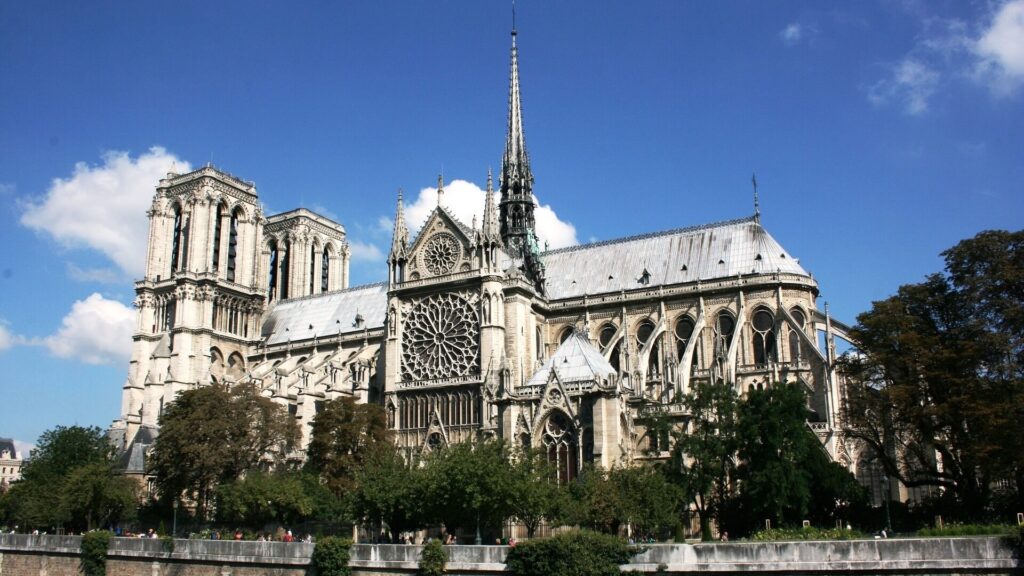
Cathédrale Notre-Dame de Paris
Notre-Dame de Paris, found in the heart of the Île de la Cité, is undoubtedly one of the world’s great medieval treasures and epitomizes the evolution from early Christian to Gothic grandeur. Its cornerstone, laid in 1163, heralded a new architectural era, with innovations such as flying buttresses and rib vaults allowing for higher structures and expansive stained glass windows.
Yet, its journey through history has been turbulent, enduring the Huguenots’ wrath in the 16th century, the French Revolution’s fervor, and the ravages of World War II. Victor Hugo’s literary homage in The Hunchback of Notre-Dame captured (and further cemented) the cathedral’s cultural and architectural significance, reviving interest and leading to restoration efforts that preserved its majesty. The cathedral’s twin towers, intricate façades, and the harmonious play of light through its rose windows continue to mesmerize.
In 2019, the cathedral tragically suffered a major fire that destroyed the building’s roof. However, this icon of Paris is set to reopen to the public in 2024 –– we can’t wait to return!
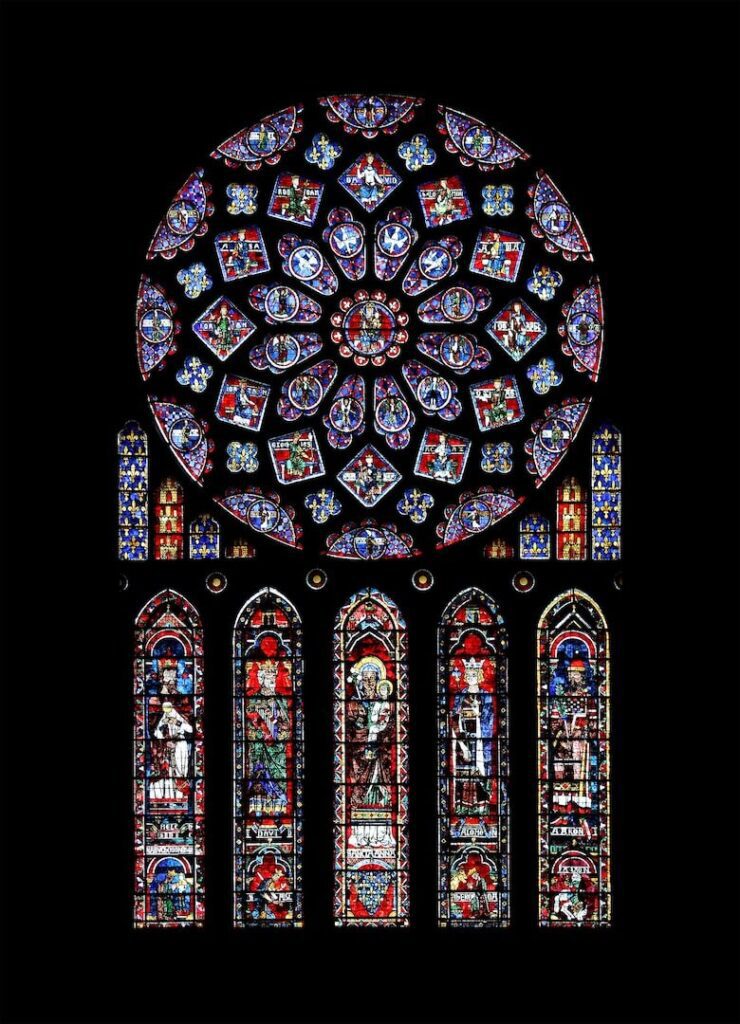
Cathédrale Notre-Dame de Chartres
The Cathédrale Notre-Dame de Chartres’ unique blue-tinted stained glass windows bathe the interior in a celestial light quite unlike anything found anywhere else.
This sanctuary has been a pilgrimage site for hundreds of years and houses what is believed to be the veil of the Virgin Mary, giving the building a profound connection with the divine. The cathedral’s structural design, incorporating a tall arcade and a narrow triforium, required a bold, innovative use of flying buttresses, setting a precedent in Gothic construction.
The sculptures adorning the Royal Portal offer a glimpse into the transition from Romanesque rigidity to Gothic naturalism, capturing human emotion and divine geometry. Chartres’ narrative is etched not just in its stones and glass but in the myriad of pilgrims’ footsteps, echoing through its vast nave and crypt. If you have yet to visit, we recommend you join the many who have enjoyed the magic of this unique cathedral since its 12th-century construction.
Cathedral of Saint-Étienne in Bourges
In the city of Bourges, the Cathedral of Saint-Étienne stands as a formidable testament to Gothic ingenuity, its magnificence acknowledged through its designation as a National Monument. Conceived as a beacon of grandeur to eclipse its Romanesque predecessor, the cathedral’s construction, beginning with the crypt and choir space, unfolded towards a façade graced by five entrances, mirroring its five internal nave – a distinctive feature lacking the traditional transept.
The cathedral’s imposing presence is quantified by its 6000 square meter expanse and towers soaring up to 58 and 66 meters, respectively. Within, the stained glass windows, spanning from the 13th to the 16th century, narrate biblical tales in vivid hues. The north tower, a climb of almost 400 steps, offers panoramic views over Bourges, while the crypt reveals exquisite Gothic stonework and houses the tombs of notable historical figures, including the Duke of Berry. The astronomical clock, a 15th-century marvel, is France’s oldest, marking the cathedral not only as a major French spiritual center but also as a testament to human innovation.
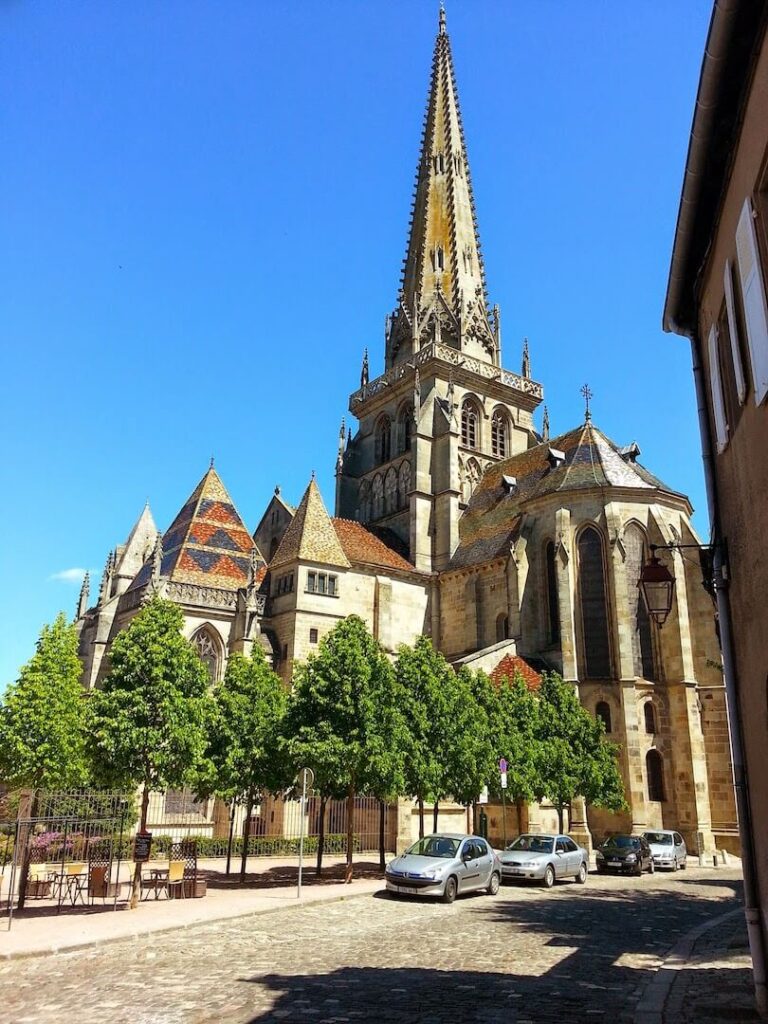
Cathedral of Saint Lazarus of Autun
Perched on Autun’s highest elevation, the Cathedral of Saint Lazarus is a masterpiece of Romanesque art. The building was erected to accommodate a growing influx of pilgrims and house sacred relics. It boasts a façade and column capitals adorned with the realistic sculptures of Gislebertus, one of the greatest French Romanesque sculptors. His sculptures, serving as visual sermons, vividly portray Christian ethics through dramatic scenes of heaven, hell, and biblical narratives.
The cathedral’s interior, a harmonious blend of nave and aisles, is punctuated by columns crowned with intricately decorated capitals, telling tales from the Flight into Egypt to the Adoration of the Magi. The Last Judgment tympanum and the Temptation of Eve lintel stand as testaments to Gislebertus’s mastery.
With its Romanesque features and a Gothic spire added in the 15th century, Saint Lazarus of Autun embodies a confluence of artistic epochs, enshrining stories in stone and captivating visitors with its historical and religious gravitas.
Cathédrale Saint-Pierre-et-Saint-Paul de Troyes
This cathedral has known many constructions, but work on its Gothic incarnation began in 1208 and continued into the 17th century. The cathedral is particularly well known for its marvelous stained glass dating from the 13th to the 19th centuries. The building’s Great Organ is also a masterpiece in its own right and embodies centuries of fascinating musical heritage.
We visit the Cathédrale Saint-Pierre-et-Saint-Paul de Troyes on our France Cathedral Tour.
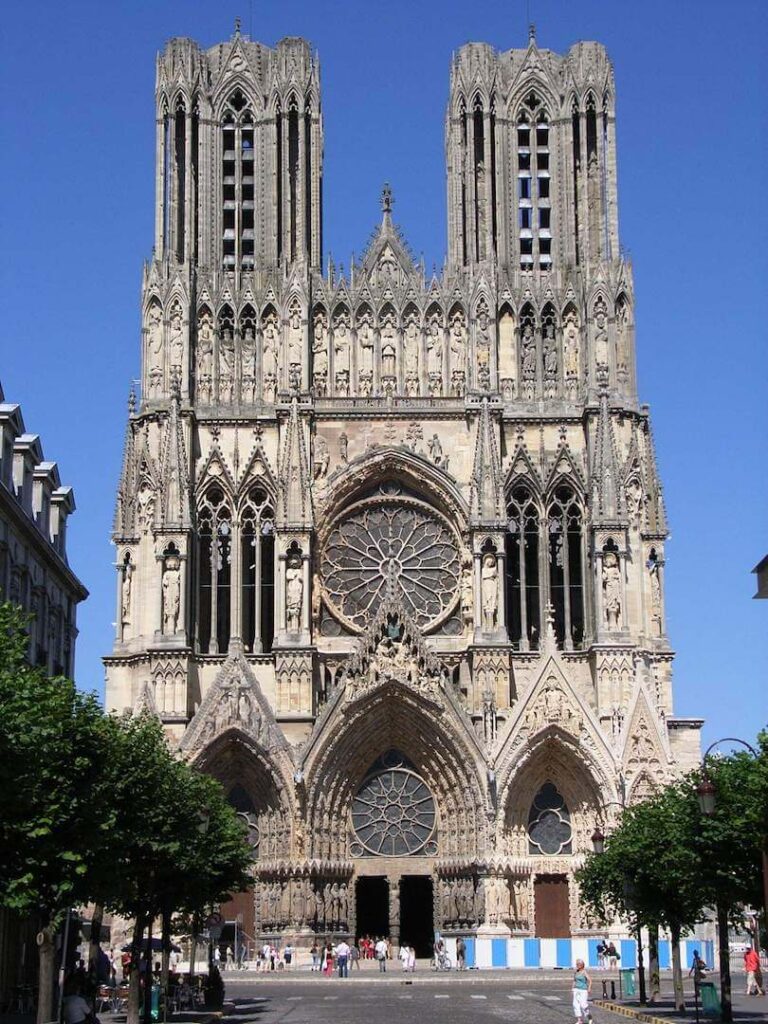
Cathédrale Notre-Dame de Reims
Reims Cathedral has witnessed centuries of French history unfold; it was here that Clovis was baptized a Christian by Saint Remigius and the cathedral was even the traditional location for the coronation of kings. Its façade, adorned with the serene smile of the Angel of Reims, invites visitors into a space where artistry and devotion converge to create something of matchless beauty.
Ravaged by the First World War, the cathedral’s survival mirrors the spirit of the nation, its restoration a testament to the enduring passion that the French have for their historical architecture and cultural treasures. Within its walls, the Palais du Tau weaves a narrative of regal splendor, housing treasures and tales of the royal ceremonies of old.
Cathédrale Notre-Dame de Laon
Laon Cathedral dominates the Laon skyline. The immense Gothic design of the cathedral was a prelude to the monumental cathedrals that were to follow. Famous for its six towering oxen statues, peering curiously from the towers, the cathedral’s lore is as intriguing as its structure.
Notable for its five towers, Laon Cathedral was initially set to have seven, including a central lantern tower to illuminate the crossing and twin towers on each transept. Although the second set of transept towers was never completed, the existing towers transition elegantly from square bases to octagonal peaks, with the western ones famously housing the aforementioned oxen, symbolizing the animals that contributed to the cathedral’s construction.
The cathedral’s stained glass, predominantly from the 13th century, includes notable lancet windows at the east end, depicting the life of Mary, Jesus’ journey, and the tales of Theophilus of Adana and Saint Stephen, complemented by a rose window honoring Mary and the apostles. Interestingly, the north transept’s rose window breaks from traditional themes, featuring personifications of academic disciplines from the trivium and quadrivium.
The geometric complexity of Laon Cathedral’s design reveals an intricate interplay of light and shadow, creating a powerful spiritual atmosphere – this is a cathedral not to be missed when traveling in France.
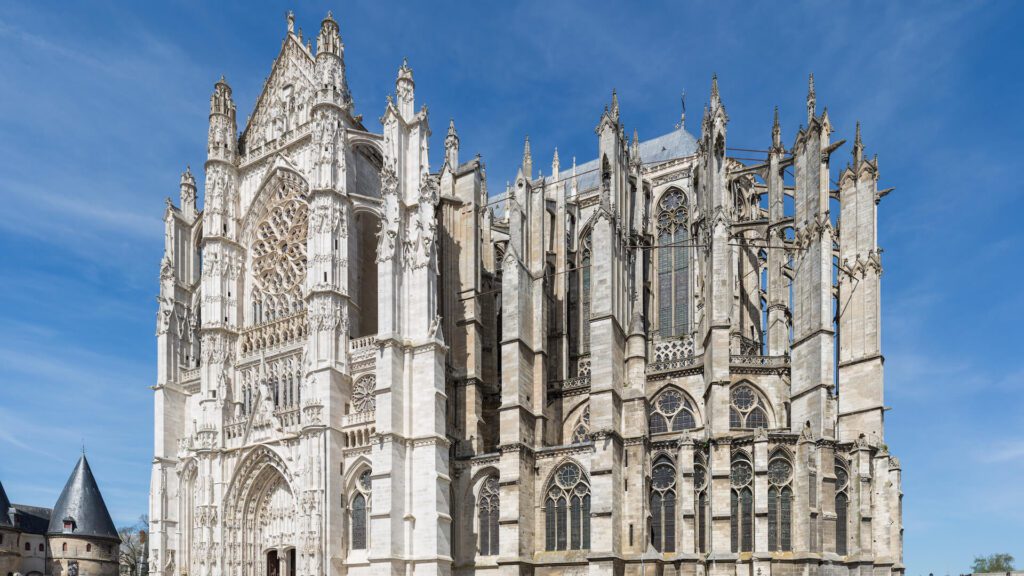
Cathédrale Saint-Pierre de Beauvais
The building of the Cathédrale Saint-Pierre de Beauvais was initiated in 1225 by bishop Milo of Nanteuil. The cathedral faced construction in two phases, marked by a stylistic shift due to a funding crisis, and under Bishop Guillaume de Grez, it briefly became the tallest manmade structure in the world at 47.5 meters.
However, the cathedral’s ambition led to a vault collapse in 1284, dampening the spirit of French Gothic masons and signaling an era of more modest structures (the choir, though, was ambitiously rebuilt with enhanced support). Esteemed for its height and artistry, the cathedral’s choir, likened to a Parthenon of French Gothic by Viollet-le-Duc, boasts rich late Gothic façades, masterful portal woodwork, an intricate astronomical clock, and prized stained glass windows crafted by Renaissance artist Engrand Le Prince.
Beauvais Cathedral, steeped in tradition and priceless historical craftsmanship, also hosted the curious Feast of the Ass, a celebration of biblical narratives in which donkeys play a role.
Cultural Tours in France and Beyond…
From the enduring spires of Notre Dame to the celestial windows of Chartres, the French Gothic cathedrals are a testament to human devotion and the creative brilliance of medieval European craftsmanship and engineering.
Consider booking your place on our Private Cathedral Tour of France. Or, if you’ve yet to decide where to enjoy your next vacation, explore our full 2024 calendar of Archaeological Tours around the world.
If you have any questions, please get in touch.


